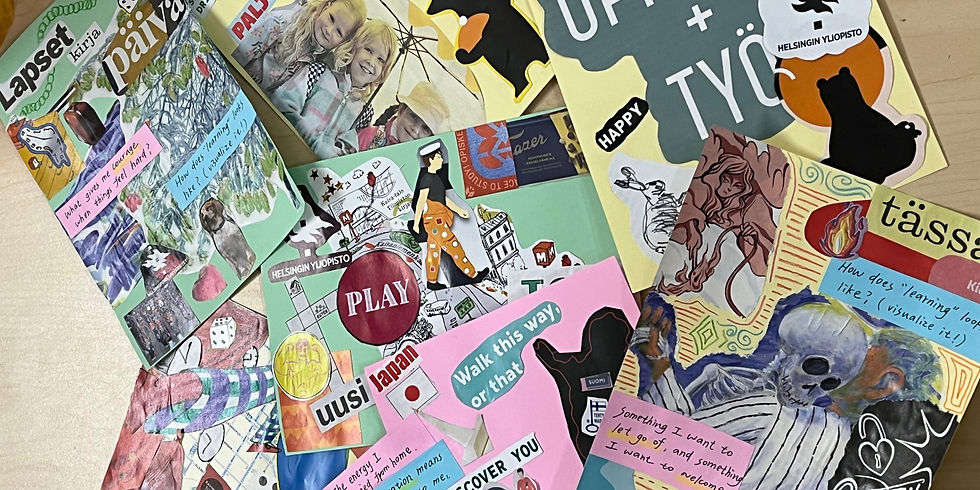The 2022 Educathon: Where Education, Innovation, and Equity Converge
- Naike Gorr
- May 27, 2022
- 6 min read
Updated: May 29, 2022
Warm welcome to everyone reading this reflective blogpost on the event of the year – The 2022 Educathon. The Educathon was a one-day event dedicated to finding solutions to making the education system more equitable. If you decide to continue reading this blogpost you will be introduced to the idea behind the event, its addressed challenge, the innovative solutions, and more.

Note: Design of logo by Aparna Shakkarwar
It all started back in February 2022 when the board of One Step Ahead (OSA)ry, the international student association of the master’s program in Changing Education at the University of Helsinki, got together. Within minutes we reached consensus that we wanted to organize an event with the aim of making education more equitable and inclusive. While brainstorming different types of events we came across the concept of hackathons, events where like-minded individuals come together to design innovative solutions for certain challenges. Due to the practical nature of these events where individuals would first be provided with relevant information and thereafter apply their knowledge and skills, we decided to organize an education-related hackathon – short Educathon!
While we did decide to predominantly focus on three aspects - race, gender and sexuality, and disability – we also wanted to highlight the importance of addressing equity and inclusivity with an intersectional approach. Here, we followed the definition of Crenshaw (1989), defining intersectionality as a lens through which one observes how various types of discrimination (e.g., racism, sexism, ableism) intersect and combine in a cumulative manner. Hence, instead of addressing each area individually, the intersectional approach stresses the fact that individuals can be subject to multiple forms of discrimination that interact thereby creating a distinct experience.
Finally, as an event of this size requires greater resources, we decided to reach out and, in the end, collaborate not only with other student associations at our faculty (i.e., Condus ry, Erikeepperi ry), but also with other Universities throughout Finland (i.e., Abo Academi University, University of Jyväskylä).
Practicalities
Following several months of intense preparation and organization, the Educathon finally took place on May 5th, 2022. On the day of the event various individuals, comprising both students and university staff, came together at the Terkko Health Hub. To ensure greater accessibility, the event was hosted in a hybrid mode, thereby enabling participants to join the event online throughout the day.
Prior to the group work, the participants listened to several presentations on the presented challenge as well as informative talks by experts in the fields. To highlight the intersectional approach, the speakers then came together during a panel discussion to discuss the importance of intersectionality while addressing the challenge. Following the panel, the participants went into teams of three to four to start the intensive work period which lasted for nearly five hours. Throughout this period, the teams were joined by coaches who answered potential questions and provided insights. Towards the afternoon, the teams presented their innovative solutions in form of a poster and short pitch. The event was concluded by a second panel discussion comprising a reflection of the event, the feasibilities of the proposed solutions, and future perspectives.
The Challenge
Now that you are familiar with the idea behind the event, we will continue this post with the presented challenge. In search of an ideal challenge, we received advice from several hackathon experts who all agreed on the notion that a hackathon is only as good as its challenge. In the end, we collaborated with Heidi Halkilahti, a pedagogical expert working at the City of Helsinki, Education division.
Our consultation with the division revealed that while there is overall awareness that racism is still a big problem in Finland, the majority of educators struggle to recognize it. As a consequence of such, the City of Helsinki, Education Division trained thousands of educators on racism and anti-racist approaches. However, while the educators obtained a theoretical understanding of this matter, their lack of self-reflection and ability to detect discrimination in their own environment limits the effectiveness of these workshops. Put differently: We are currently trying to tackle various types of discrimination by providing information, without focusing on the ones that do not recognize the problem to begin with. This phenomenon is also applicable to other programs, teacher workshops, and materials on different types of discrimination and inclusion, and visible in different contexts within the educational domain.
As a consequence, we presented the following challenge: How do we ensure that structural inequalities are more visible in educational environments?
The Speakers and Coaches
There were three main speakers introducing their field of expertise and how the presented challenge is visible in it. The first presentation was held by Meg Jones who researches queer topics in education with a focus on teacher education and classroom inclusion. During the presentation, Meg addressed
the question of how to ensure that structural inequalities are more visible in the educational domain by considering various levels ranging from the global to the individual level.
The second presentation was held by Emmanuel Acquah whose research interests comprise antiracism as well as advancing equity and culturally responsive teaching in the training and practice of educators. During the presentation, Emmanuel discussed the distinction between being a non-racist and being an anti-racist, highlighting the importance of confronting racial inequality instead of being racially neutral.
The final speaker was Sanni Purhonen who works at a cross-disability organization that focuses on basic and human rights of persons with disabilities. Sanni first introduced different models of disability, advocating for the social model claiming that disability is caused by society instead of the disabled individual. Thereafter, Sanni concluded that while structural inequalities concerning disability are generally more visible, the problem concerns the fact that disabled people need to be welcomed in educational environments.
Additionally, the event was supported by experts on antiracism (Amiirah Salleh-Hoddin, Josephine Holmström, Nora Repo-Saeed) and EdTech innovation (Solja Sulkunen) who coached the teams throughout the day. If you are interested in the presentations or the panel discussion, please see the links below the blogpost where you can find the speaker slides as well as the recording of the day.
The Innovative Solutions
In the end, the Educathon led to the design of five innovative solutions aimed at increasing the visibility of structural inequalities in the education environment. The majority of the teams proposed their solutions in the forms of programs or material which were intended to provide parents and educators with the required support and knowledge to identify and thereafter counteract discrimination in the educational domain.
For example, one team presented an open resource bank comprising storytelling kits to facilitate an active discussion on inequalities between primary school teachers and their students. This resource included age-appropriate stories, suitable activities, and discussion guides that would be available to all teachers. Another team proposed a so-called ambassador program which firstly identifies the needs of the teacher and parent body. Thereafter, the ambassadors aim to provide the required support in form of information and the facilitation of action. Finally, due to the importance of self-reflection, the program provides a platform where stakeholders in education can reflect and create a dialog on diversity and marginalized groups. If you are interested in reading more about these innovative solutions, please see the link below the blogpost directing you to the participants’ posters.
Conclusion
Looking back at the 2022 Educathon, several conclusions can be drawn. Firstly, while the 2022 Educathon represents the first of its kind at our universities, we truly hope it will not be the last. Instead of remaining a one-time event, we seek to inspire others and especially those following in our
shoes to organize a yearly, reoccurring Educathon series. Hosting events that aim to address challenges as contemporary and relevant as this year’s challenge, is of utmost importance to continuously fight for and increase the awareness of greater equity and inclusivity in the educational domain. While anti-discrimination programs and resources are not new and have existed for a long time, there is still a long way to go in order to reach educational equity and inclusivity.
Secondly, in addition to inspiring and motivating others to host subsequent Educathons, we also wanted to encourage the participants of the 2022 Educathon to continue working on and finalizing their products. In this context, Solja Sulkunen presented the EdTech Incubator program at the Helsinki Education Hub which provides guidance and support for startups with ideas such as those presented at the Educathon. While this challenge is experienced by the City of Helsinki and hence brought forward by their education division, it is also visible in other organizations and on different levels of education. Hence, turning these theoretical ideas into practical products would not only support the City of Helsinki but could also be implemented by various stakeholders in education.
Thirdly, since this event required greater resources and hence was made possible through a team effort, we would like to advocate for future collaborations with other student associations and universities. Greater collaboration at our university as well as across universities would ensure greater accessibilities and outreach of these events.
Finally, on behalf of OSAry, I would like to thank each and every one of you that has made this event possible by participating or contributing your expertise, time, and resources.
Materials and Sources

------------------------------------------------------------------------------------------------------------------------------------------------------------------------------------------------------------------------
Recordings of the day:
Still being processed
Slides of the speakers: https://drive.google.com/drive/folders/1fpCBYYPrZ8RF3tU6RryGaIAZUYB8Bdf5
Posters of the solutions: https://drive.google.com/drive/folders/1Jld9cQhA32twJ7LWEmMK_ang9k4yUwBf
Bibliography:
Crenshaw, K. (1991). Demarginalizing the intersection of race and sex: A black feminist critique of
antidiscrimination doctrine, feminist theory, and antiracist politics. In Feminist legal theory (pp. 57–80). Routledge. https://doi.org/10.4324/9780429500480-5

-----------------------------------------------------------------------------------------------------------------------------------------------------------------------------------------------------------------------

Hey there! My name is Naike Gorr and with an academic background in psychology I am currently studying the Changing Education Master’s program. Additionally, I am the event manager of One Step Ahead (OSA)ry, the international student association of the master’s program in Changing Education at the University of Helsinki. While my research interest covers a wide variety of topics, I am most passionate about improving education to prepare the current generations for the upcoming challenges by taking an educational policy perspective.
Educathon, Hackathon, Equity, Inclusion, Intersectionality
-----------------------------------------------------------------------------------------------------------------------------------------------------------------------------------------------------------------------




Comments